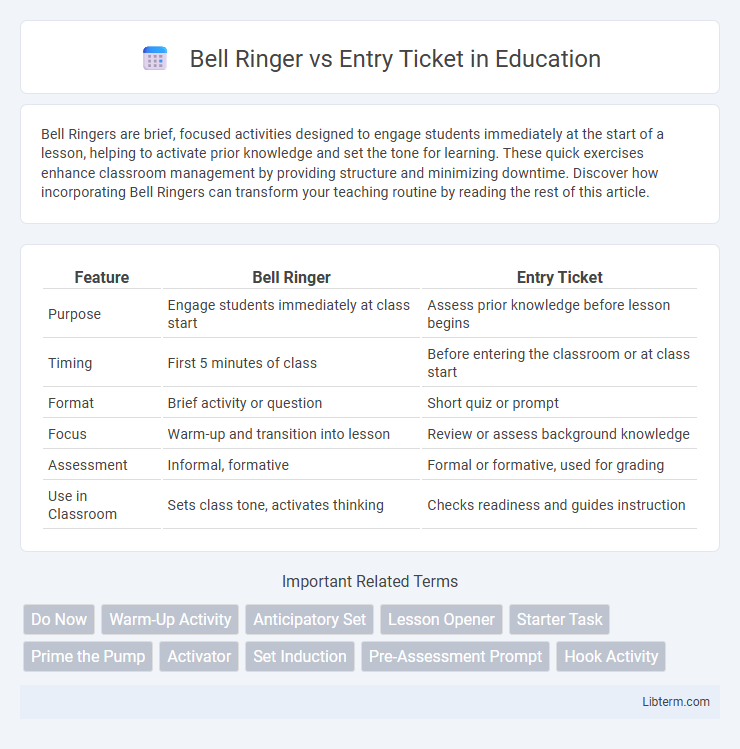Bell Ringers are brief, focused activities designed to engage students immediately at the start of a lesson, helping to activate prior knowledge and set the tone for learning. These quick exercises enhance classroom management by providing structure and minimizing downtime. Discover how incorporating Bell Ringers can transform your teaching routine by reading the rest of this article.
Table of Comparison
| Feature | Bell Ringer | Entry Ticket |
|---|---|---|
| Purpose | Engage students immediately at class start | Assess prior knowledge before lesson begins |
| Timing | First 5 minutes of class | Before entering the classroom or at class start |
| Format | Brief activity or question | Short quiz or prompt |
| Focus | Warm-up and transition into lesson | Review or assess background knowledge |
| Assessment | Informal, formative | Formal or formative, used for grading |
| Use in Classroom | Sets class tone, activates thinking | Checks readiness and guides instruction |
Understanding Bell Ringers and Entry Tickets
Bell Ringers and Entry Tickets are formative assessment tools designed to engage students at the start of a lesson, with Bell Ringers typically consisting of quick tasks that prime students for the upcoming content. Entry Tickets function as brief assignments or questions students complete upon entering the classroom, providing teachers with immediate feedback on prior knowledge or readiness for new topics. Both strategies support classroom management and instructional pacing by establishing routines that activate students' critical thinking and readiness to learn.
Purpose of Bell Ringers in the Classroom
Bell ringers serve as quick, focused activities designed to engage students immediately upon entering the classroom, priming their minds for the lesson ahead. These tasks often review previous material or introduce new concepts, establishing a productive learning atmosphere and minimizing transition time. Utilizing bell ringers effectively enhances student readiness and maximizes instructional time by fostering instant academic engagement.
Entry Tickets: An Overview
Entry Tickets serve as quick formative assessments designed to gauge students' prior knowledge or readiness at the start of a lesson, providing teachers with immediate insights to tailor instruction. Unlike Bell Ringers, which often include warm-up activities, Entry Tickets specifically require students to respond to focused prompts or questions linked to upcoming content. This tool enhances engagement and informs differentiated teaching strategies by capturing real-time student understanding.
Key Differences Between Bell Ringers and Entry Tickets
Bell ringers are short activities designed to engage students immediately as class begins, often reviewing previous material or setting the tone for the lesson, while entry tickets require students to demonstrate specific understanding or respond to a prompt related to the day's objectives. Bell ringers typically serve as warm-up exercises without formally assessing students, whereas entry tickets function as formative assessments to gauge comprehension and inform instruction. The key difference lies in their purpose: bell ringers focus on activating prior knowledge, whereas entry tickets focus on measuring learning readiness or mastery.
Benefits of Using Bell Ringers
Bell ringers enhance classroom engagement by providing students with focused, quick activities that activate prior knowledge and prepare them for new lessons. They help establish routine and structure, promoting a smooth transition into the learning environment. By encouraging immediate participation, bell ringers improve student accountability and enhance overall instructional time efficiency.
Advantages of Implementing Entry Tickets
Entry Tickets enhance classroom management by providing a focused start to lessons and immediately engaging students with content-relevant tasks. They offer valuable formative assessment opportunities, allowing teachers to gauge prior knowledge and tailor instruction accordingly. Implementing Entry Tickets fosters accountability and encourages punctuality, as students must complete the task upon entering the classroom.
When to Use Bell Ringers vs Entry Tickets
Bell ringers are ideal for the very beginning of a class to quickly engage students and activate prior knowledge within the first few minutes. Entry tickets work best as students enter, serving as a formative assessment tool to check understanding or gather feedback on previous lessons. Use bell ringers to set the tone and transition into new content, while entry tickets help teachers gauge comprehension before the lesson officially starts.
Examples of Effective Bell Ringers
Effective Bell Ringers include quick writing prompts such as reflecting on a key concept from the previous lesson or solving a math problem related to the day's topic. Examples like summarizing a short article on climate change or identifying parts of speech in a sentence engage students immediately and set a focused tone. These activities activate prior knowledge and provide immediate feedback, making transitions into deeper learning smoother and more productive.
Creative Entry Ticket Ideas for Engagement
Creative entry ticket ideas for engagement include themed quizzes related to lesson objectives, interactive challenges like word searches or puzzles, and reflective prompts encouraging personal connection to the topic. Entry tickets designed with visual elements or multimedia components can increase student interest and participation. Incorporating gamified elements or collaborative tasks within entry tickets also fosters active learning and classroom interaction.
Choosing the Right Strategy for Your Classroom
Selecting the right strategy between Bell Ringer and Entry Ticket depends on your instructional goals and classroom dynamics. Bell Ringers are effective for activating prior knowledge and setting the tone for the lesson, while Entry Tickets assess students' understanding before starting new content. Teachers should analyze student needs, lesson complexity, and desired outcomes to decide which approach fosters engagement and informs instruction most effectively.
Bell Ringer Infographic

 libterm.com
libterm.com